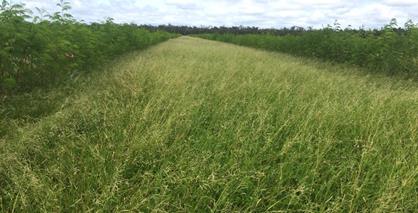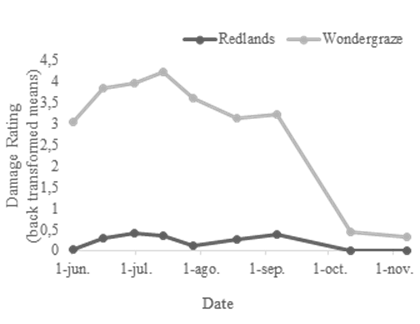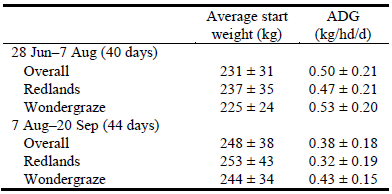Introduction
Leucaena is a rapid-growing, perennial, leguminous tree with the potential to sustainably intensify beef production in the northern rangelands of Australia (Harrison et al. 2015). Adoption of leucaena in the northern Australian beef industry has been slow, partly due to the prevalence of the sap-sucking leucaena psyllid (Heteropsylla cubana). Recent efforts to develop new psyllid-resistant varieties have resulted in the release of cultivar Redlands, which has the potential to improve beef production in northern environments. A large-scale trial has been established to compare liveweight gains of cattle grazing Redlands, with that of the established cultivar Wondergraze in a psyllid-prone environment of north Queensland. This paper presents some preliminary results from the trial as the grazing phase commenced only in June 2018. Weight changes of successive groups of weaner steers (Bos indicus type) will be monitored over at least three 12 month grazing periods. Stocking rates in the first year are light to protect young leucaena plants, but will be increased in subsequent years when the leucaena is fully grown.
Materials and Methods
Preparation of trial site and psyllid monitoring
A 61 ha cleared trial site was selected at Pinnarendi Station (18.03849º S, 144.872453º E; 759 masl) on yellow to red-brown granite-derived soil with an average pH of 6.4 ± 0.07. Average annual rainfall is approx. 690 mm with the majority falling between November and April. Soil phosphorus and sulphur concentrations were low (5.1 ± 0.06 and 2.6 ± 0.15 mg/kg, respectively).
Prior to the 2016/2017 wet season, plant rows were set-out and prepared by strip cultivation. Superphosphate (9% P, 11% S) was applied at 300 kg/ha (27 kg P/ha; 33 kg S/ha) to a 1 m strip along plant rows before planting. Two leucaena treatments, cvv. Redlands and Wondergraze, were sown in an 8-paddock paired block design (Figure 1) in early 2017 during the wet season. After initial establishment, superphosphate was again applied at 280 kg/ha (25 kg P/ha; 31 kg S/ha) to a strip over the plant rows. Six months after planting, granulated sulphur (90% S) was applied over the leucaena rows at 160 kg/ha (144 kg S/ha) to provide sulphur for leucaena over the longer term; superphosphate was broadcast across the whole site at 240 kg/ha (22 kg P/ha; 26 kg S/ha) to promote growth of the inter-row pasture. In February 2018, a contingency application of custom-blend fertilizer (12% N, 11% P, 10.5% S) was applied at 250 kg/ha (30 kg N/ha, 27.5 kg P/ha; 26 kg S/ha) over a 3 m strip along plant rows to address apparent suboptimal growth of leucaena during the 2017-2018 wet season.
Existing inter-row pasture species were retained and included Indian couch (Bothriochloa pertusa), Wynn cassia (Chamaecrista rotundifolia), Sabi grass (Urochloa mosambicensis) and Stylosanthes spp. The leucaena and pasture grew well, helped by useful late rainfall in May 2017 and unseasonal rainfall in October of the same year (Table 1, Figure 2).
Table 1 Pinnarendi actual rainfall for 2017 and 2018 and the long-term median from the closest weather station.

1Long-term median from Meadowbank weather station (1956‒2017; Bureau of Meteorology) located in the district.
The Pinnarendi site was deliberately selected in an environment where psyllids were known to be prevalent so that any productivity difference between Redlands and Wondergraze caused by psyllid damage could be expressed. No attempt is being made to control psyllids. A monitoring program using 9 sentinel plants per paddock (9 × 8 = 72 plants total) was set-up to record the degree of leaf damage caused by psyllid infestations. A modified rating scale (Wheeler 1988) was used, where 0 is no psyllids present and 9 is blackened stems with total leaf loss. Assessments were made on 9 occasions in 2017 and 4 in 2018.
Grazing Trial
The Queensland Department of Agriculture and Fisheries (DAF) Animal Ethics Committee approved animal handling and experimental procedures (SA 2017/12/628). Consistent groups of cattle have been grazing on the trial site since late June 2018 comprising 16 Droughtmaster (stabilized Bos indicus × Bos taurus) steers and 12 Brahman cross (Bos indicus × Bos taurus) steers. There are 4 treatment groups with 7 animals/group blocked according to breed (4 × Droughtmaster and 3 × Brahman cross per group) and weight (to achieve relatively similar initial total group weights). The groups were assigned at random to either Redlands or Wondergraze treatments. Sampling of biomass to estimate dry matter yields was done in the inter-row pasture in late July 2018. Leucaena biomass was sampled in paddocks 1‒4 on 16 August prior to cattle entry and again after cattle were removed on 28 September. Paddocks 5 and 6 were also sampled in mid-September before cattle entry. A weather station was installed to monitor rainfall, temperature, wind speed and solar radiation. Electronic monitoring systems track tank water levels, while cameras remotely monitor watering points and cattle, while they are in proximity of the watering points.
Results
Establishment and psyllid observations
Growth of leucaena during the 2017-2018 wet season was suboptimal, despite earlier fertilizer applications. Potentially, this was attributable to nitrogen deficiency, caused by poor root colonization with non-viable rhizobium inoculum (CB 3126) applied to seed before sowing. Overall, establishment of Redlands was worse than that of Wondergraze owing to differences in germination rates (30‒45 vs. 80‒90%, respectively). However, Redlands mostly compensated with increased growth so that final biomass was relatively uniform across all paddocks with the exception of Paddock 8, which has produced poorly.
Psyllids were active across the trial site from May to September 2017. Monitoring of incidence and damage showed that Wondergraze suffered significantly more damage than Redlands (Figure 3), but Wondergraze recovered quickly once psyllid pressure declined after September. Psyllid populations and damage were comparatively low during 2018 and are not reported. Inter-row pasture biomass (dry matter basis, DM; ± s.e.) was 6,020 ± 1,527 kg/ha across replicate paddocks at the site early in the dry season (late July 2018), comprising about 45% legume and 55% grass. Edible biomass (leaf and stem <5 mm diameter) of leucaena was only 65 ± 33 kg DM/ha in early July 2018 but had increased to 158 ± 51 kg DM/ha by late September in paddocks which had been spelled since late June. This was due to warming weather as there was no significant rain at the site since March 2018. Average daily liveweight gains (ADGs) have been determined for Redlands and Wondergraze treatments for the period of grazing from weighing events conducted in August and September 2018 (Table 2). These data are preliminary only and have not been analyzed for statistical significance. During this period, trial animals were also sporadically fed molasses (equating to about 2.5 MJ ME/hd/d) to accustom them to routine handling.
Discussion and Conclusions
Preliminary results from the initial 3 months of grazing in the trial show cattle are gaining weight during the dry season with ADGs of about 0.4 kg. This is considerably higher than would be expected from native pastures at the same time of the year. While leucaena yield was low during the period and the grass-legume inter-row pasture will have contributed to this figure, leucaena was the only green feed available in the paddock and was high quality. Redlands was consumed readily by trial animals. To date, Wondergraze paddocks have produced slightly higher ADGs than those containing Redlands leucaena. However, the difference is not yet considered to be significant and the contribution of the inter-row pasture needs to be clarified. While psyllid resistance of Redlands was demonstrated during 2017, psyllid infestation during grazing in 2018 has been light and has not reduced growth of Wondergraze relative to Redlands. Performance of animals over the next 2‒3 years is required to fully test the productivity of Redlands relative to Wondergraze grown within legume-grass pastures over a range of seasonal conditions.



















